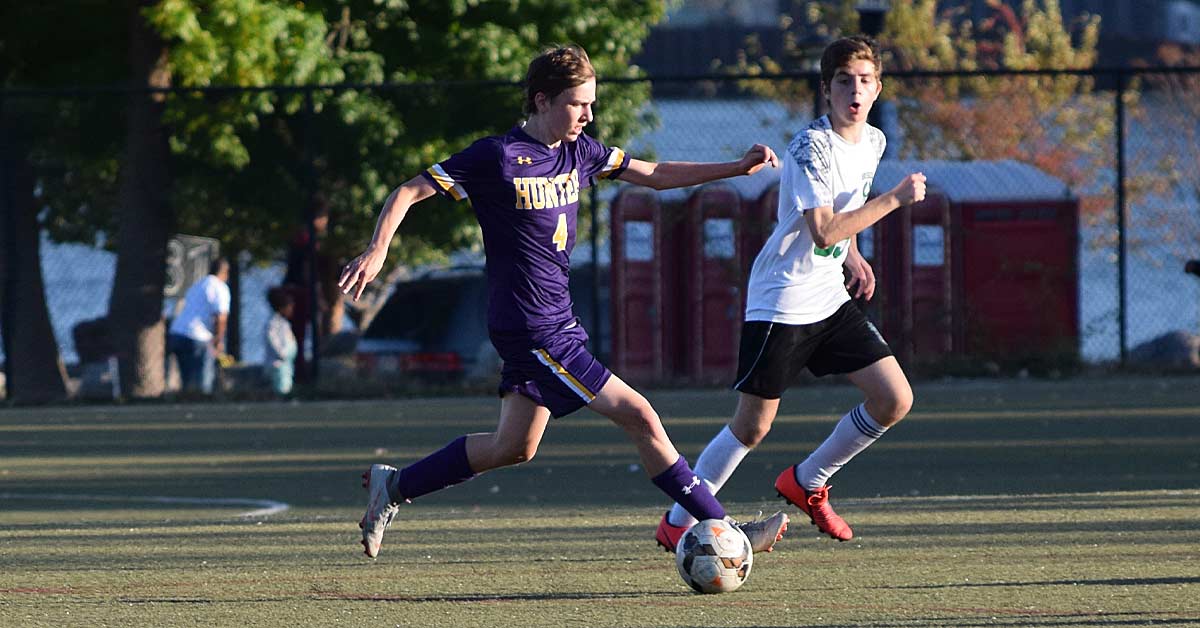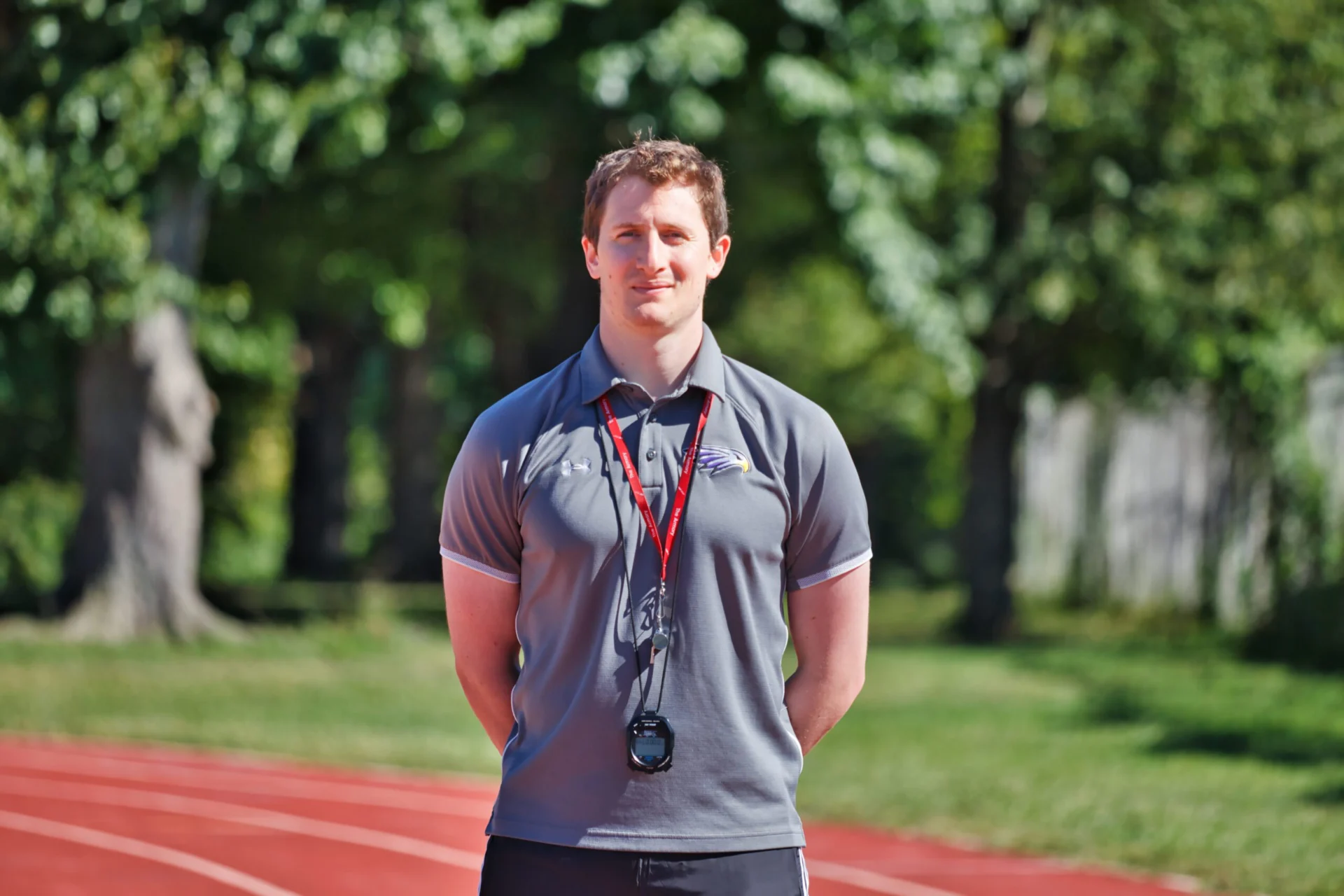Without a vision for success, you cannot design the process necessary to realize your goals. My coaching story begins with that vision, but the story I’d like to share aims to instruct on the process. I hope that new coaches (or even veterans) will benefit from this analysis of my time with the Hunter Boys Varsity and Junior Varsity Soccer team. After four years coaching the team (three as head coach), I asked my graduating seniors to reflect on their experiences. This is their reflection as much as it is my own.
Hunter College High School (HCHS) is not your average school—its graduates consistently go on to attend Ivy League universities and top academic institutions like Stanford, MIT, and Duke. The school offers an array of challenging coursework and student-run extracurriculars ranging from cultural clubs to academic competitions. The school also boasts more than 40 sports teams for grades 7–12, but graduates are rarely recruited to Division 1 teams.
As an alum, I fit the HCHS student-athlete archetype: I played soccer, swam competitively, and ran track. I contributed significantly to the success of each team because I was a decent athlete who trained hard and led by example. You can imagine my surprise when I was promptly cut from Cornell University’s D1 Men’s Track & Field team after fall training—very simply, I wasn’t good enough to make the team.
That moment became my athletic inflection point.
Getting cut motivated me to ask questions about my high school sports experience that I hadn’t previously considered. Today, my coaching embodies the answers to those questions.
When I returned to HCHS as an assistant soccer coach in 2016, I wanted to lead a team for which sport was more than a means to diversify a college application. I wanted an experience that rivaled the value students and parents placed on the debate team, science research, and music performance groups. I wanted to coach a soccer team that could serve as a course in training theory, personal maturation, teamwork, and leadership for its athletes.
I wanted to coach a soccer team that could serve as a course in training theory, personal maturation,teamwork, and leadership for its athletes. Share on XA few problems immediately stood in the way of that vision:
- Minor injuries occurred frequently.
- Our team’s performance depended too much on the presence of a few individuals.
- Our offense appeared chaotic and unguided by style or strategy.
To address these concerns, I needed a multi-year plan to cement lasting improvement and shift the culture of our team. I wasn’t trying to craft a miracle. I wanted to facilitate a better experience for my athletes—the experience I never had. I lost my junior year soccer season due to injury. In high school, our team’s individual skills were great, but our teamwork was poor. Failing to address these problems in my own athletic experience, I became motivated to prevent such failures for the athletes I was coaching.
Balancing Fitness and Skill Development
To address the team’s offensive strategies, I began watching more professional soccer and reading the relevant literature. I also tried my best to listen to my athletes and logically apply their feedback as often as was reasonable. I presented various feedback opportunities to my athletes over the past four years, but they were never so formalized as the reflections I collected at the end of our fall 2019 season, which I have included here.
- “I witnessed quite a few injuries during my time, including a broken wrist of my own during my freshman year on the team. The rate of catastrophic injuries was relatively stable throughout my first three years on the team. This year, on the other hand, we had almost no injuries—which is nearly unheard of on a team of more than 30 guys. Although this could be attributed partially to luck, I think the focus on strength training, adequate stretching, and healthy eating all contributed to our improvement. I am far from the strongest guy on the team, but this year I felt confident and safe on the field throughout the entire season.” – Eric, Midfielder, Class of 2020
Eric was a crucial member of our midfield, and his comment on luck is humbling because good fortune will always claim a role in sports injury assessment. I make no exception for Hunter Boys Soccer; however, Eric’s evaluation of catastrophic injuries is somewhat inaccurate. Injuries persisted throughout his first three years on the team, but they diminished more than Eric acknowledges in his reflection.
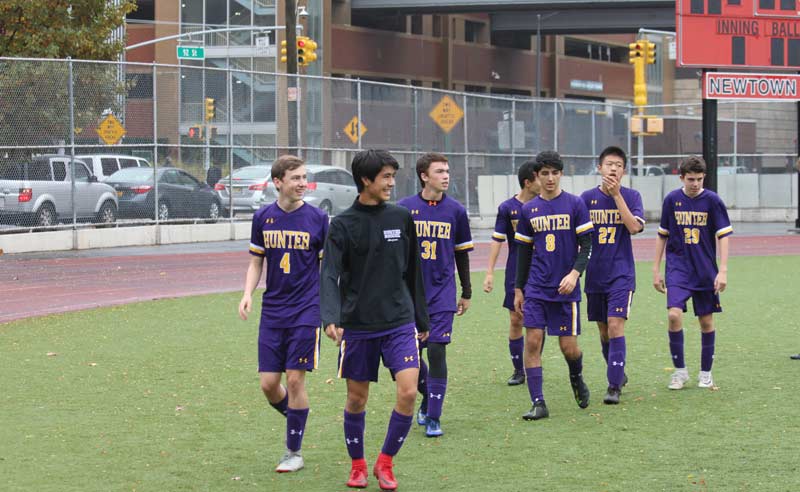
In fall 2016, Eric’s first year on the team, we lost five athletes to significant bone or muscular injury. In Eric’s senior year, fall 2019—when strength training shared the greatest portion of practice time since its introduction to the team—we had zero catastrophic injuries. Each year forward saw fewer athletes with a similar degree of injury. As one of Eric’s senior teammates explains below, the benefit of increased strength training extended well beyond injury prevention.
- “While my teammates may not have appreciated it enough, each year saw massive improvements which played a role in getting us through longer games. For instance, in the round of 16 playoffs match of fall 2019 season, we played the full 80 minutes, plus extra time, and into penalties. Even in the last few minutes of extra time, our team was able to keep pushing forward and this was mainly due to improved stamina and conditioning.” – Matthew, Midfielder, Class of 2020
Matthew was another excellent midfielder who benefited greatly from our new balance of fitness and skill development. He was a proficient playmaker, moving the ball effortlessly from defense to offense, but I often worried that his thin physique increased his risk of injury in harder tackles. Matthew improved his deadlift by more than 50 pounds from his junior to senior year, and he saw less significant improvements—but improvements nonetheless—in his other lifts over the same period.
While the wider athletic community and its highest-level practitioners have known how crucial strength and conditioning is for competitive and recreational sports for decades, its intrinsic value remains poorly emphasized, or utilized, in most youth sports programs in New York City. In public high schools and athletic clubs, I have not observed coaches balancing the physical demands of their athletes’ technical skills. My experience as both a youth athlete and a coach in the city reinforces this training deficiency.
I introduced mandatory strength and conditioning to my soccer team because my coaching education indicated it was the obvious solution to reduce injuries. Many stakeholders on the team didn’t see it that way—initially, strength and conditioning was undervalued by my players, some of their parents, and even my athletic director.
Many of my soccer players didn’t want to hear that they needed less time playing soccer and more time in the weight room…In all fairness, players were right to assert their skepticism. Share on XNo different than my observations, my team struggled to adopt this new balance between fitness and skill development. Many of my soccer players didn’t want to hear that they needed less time playing soccer and more time in the weight room. Without getting too esoteric on the peer-reviewed sports medicine literature, I would tell athletes and parents, “You spend less time preventing injury than time lost due to being injured.” The bumper sticker ideology only carried so far, but as you’ll see, they eventually embraced this philosophy.
- “I needed preseason to reaffirm my soccer skills and get comfortable with the team before I was able to perform to the highest of my ability. With a greater focus on strength work, I had trouble feeling comfortable on the field until midway through the season. However, by the end of the season, I felt better than I probably would have felt without strength training.” – Eric
In all fairness, my players were right to assert their skepticism. I was a first-time head coach and didn’t want to close myself off to feedback. Some of my practice drills were too complicated, and my judgments on positioning overlooked seasoned relationships between certain players. I knew how I wanted my team to play, but I was still working out my process for getting there.
- “Practices weren’t necessarily seen as the best use of our time, since there was often discussion and explanation before our drills. Usually, I preferred drills that were rote repetition of a simple action or a combination of simple actions.” – Ben, Defender, Class of 2020
Ben was never an obstinate or obstructive player. He offers a glimpse at what was clearly on the minds of his teammates during my early years. Explanation of drills can feel redundant when athletes have performed them before, but a team deserves time for reflection on their collective and individual choices. As a coach, you have to guide those conversations to keep players’ comments positive, discrete, and goal oriented. Over the years, I have simplified the drills and promoted older players in leading reflections.
On the Offensive
A fast-paced possession game, in which no player holds onto the ball longer than two seconds, requires being in the right place at the right time. The speed and endurance necessary to sustain that style of play came from sprints in our warm-up and time in the weight room. I encouraged my players to perform their cardio development on their own.
The more difficult, cognitive component of “right place, right time” demanded a familiarity and trust among players through our drills in practice, which focused on perception, anticipation, and reaction to ball movement. Some coaches refer to these skills as “soccer intelligence” or “cognitive soccer.” With our offense, I emphasized cognitive soccer in practice over and above individual technique.
My emphasis on individual cognitive skills was foundational for building trust between players. Once that trust existed, I let my best 11 players solve their own tactical problems. Share on XIn fact, prior to coaching, I never realized that my success as a player derived greatly from my own cognitive skills rather than my footwork or finesse with the ball. My perception, anticipation, and reaction were instrumental to the tactical choices I made in a game, so it is no wonder I coach the Hunter Boys Soccer team the same way. My emphasis on individual cognitive skills was foundational for building trust between players. Once that trust existed, I let my best 11 players solve their own tactical problems.
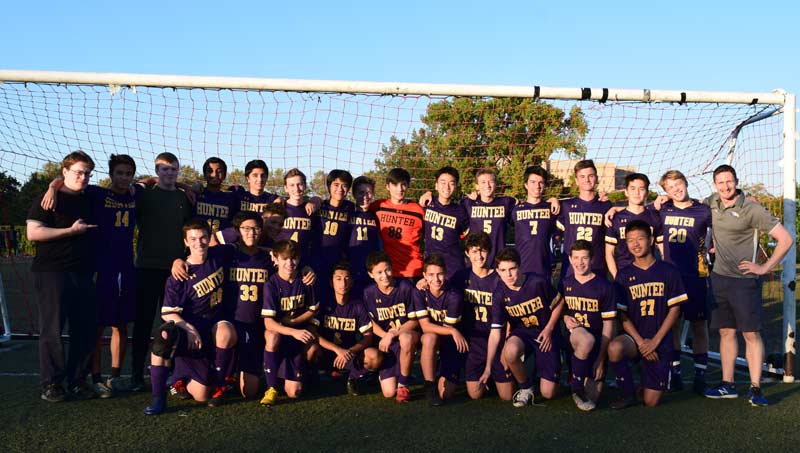
Substitutes are not second-rate players when they train similarly to the starting 11. Instead, they serve as they are named: replacements to starters with little disruption in the relentless pursuit of scoring goals. In our league, substitutions are unlimited, and players are allowed re-entry.
Though our wingers are generally the most athletic players on the team, the demanding nature of their position requires frequent substitution. Speed and strength endurance underwrite their ability to defend, counter, sprint, and cross the ball. This strategy continues to work well for us. In addition to their athleticism, I appreciate our wingers who ask for a substitution when they feel fatigued. The weight room is a great place to acquaint yourself with humility.
I emphasized a style of play contingent upon positioning and quick-paced, intelligent passing. Strength and speed training prepared my team to play their game faster and more consistently than their opponents through the full 80 minutes or more.
Ideally, good clean soccer maintains possession and avoids dangerous tackles. Inevitably, this forces your opponents to utilize dirtier tactics to retrieve the ball, so increases in absolute strength became a necessity. I used the one rep max as my indicator for the ability to withstand a tackle.
This time in the weight room may have come at the cost of practicing fundamental skills, such as dribbling and shooting, but I didn’t believe many players needed to practice those fundamentals beyond the early part of our season. Most Hunter soccer players arrived already proficient, or even advanced, in those fundamental skills as freshmen because they had been playing soccer for several years with a local club team. The August preseason refreshed those fundamental skills—then, we gradually moved away from basic drills to embrace cognitive skills as the season progressed.
- “…For any school team, the club players who spend all year playing soccer were able to translate these skills in the high school season and become standout players. Without a coach who was well-versed in soccer-specific drills and tactics, players were left wanting more out of each practice. While this lack of knowledge may have stunted technical growth, I feel our team was still able to develop physically and psychologically over my four years.” – Matthew
I admit that offensive tactics remain the weakest component in fulfilling my vision for the team, but Matthew’s words amplify the improvements made despite the weakness. I suspect Matthew’s concern for “specific drills and tactics” derived from his early soccer education. A different style of play probably would benefit my professional development, but it’s also possible those “specific drills and tactics” fit Matthew’s expectant style of play alone. If it challenged or slowed the organic, unified growth of our team, then I’m comfortable with their exclusion.
Matthew was a fantastic soccer player, whom I could trust with leading drills and fostering team culture. He wasn’t the coach. Each year, I had to be mindful of those differences to continuously craft a cognitive offense.
- “Learning how to function relative to my teammates was something that came out of drills that allowed for multiple decisions, like a simple 3v3 possession drill, where you get a bit of a feel for how your teammates both defend you and move around you. It’s a wonderful feeling to be able to predict your opponent or your teammate and make a play off of that intuition.” – Ben
Teamwork took its shape organically from the trust developed between naturally talented players and teammates who made up for their skill deficits with hard work. We will always have keystone players, but strength and conditioning has diminished our reliance on them, creating a synergy for any individual player to insert themselves into the game smoothly without harming the offensive or defensive strategy.
We will always have keystone players, but strength and conditioning has diminished our reliance on them. Share on XI expect that cognitive soccer will remain the core of our offense because gameplay encounters minimal disruption with our seniors’ departure. As long as the underclassmen have been practicing alongside older teammates and pushing numbers in the weight room, I expect a seamless transition to the new season.
Confidence Is Key
Confidence is a hard variable to measure: it’s intangible and unquantifiable. I have a few indicators to gauge team confidence, but I recognize that their credibility is limited.
At a selective preparatory high school like Hunter, there are innumerable competing factors for a student-athlete’s time. Music lessons, math tutoring (as tutor or pupil), debate team, school publications, and science competitions are just a few of the activities that consume students’ time besides their usual 3+ hours of nightly homework. Practice attendance may not be a great indicator for commitment outside of our school community, but it’s a reasonable gauge for our team.
- “Everybody showing up is crucial to encouraging a motivated team.”– Ben
I counted many more absences in my early days coaching. Athletes show up because they know what you’re doing for them—and what they’re doing for each other—has value. Like I noted earlier, I began relying more on low-stakes games for warm-ups—like Lions & Tigers, variations on tag, and relay races— merely to increase the fun factor. As Tony Holler preaches, “lighting a fire” or “filling their tank” instead of draining it is the easiest way to keep kids coming back.
- “One of the most significant differences that I’ve noticed throughout my time on the team is a change in the team’s mentality. With each passing year, I feel like the team has become more tightly knit and inclusive. As a freshman, I had a close bond with my fellow freshman members of the team, but I felt quite isolated from the rest of the team. Lacking the skill or fitness to compete for a starting spot, I wasn’t as motivated as I should have been at practice and saw the road to getting a starting spot as a matter of others leaving at the end of the year rather than me getting better myself. However, the level of commitment and devotion that I have seen from current freshmen and sophomores has improved significantly since my time in their shoes.
- I believe that this change in mentality is a result of a more inclusive, but also a more competitive, environment where freshmen are seen as more than just benchwarmers. This season, both freshmen and sophomores were consistently present on the starting lineup, which had a big impact on the morale of younger players and the work ethic of older players, who were pushed beyond complacency.”– Eric
Eric’s reflection brings tears to my eyes. His words capture the first time anyone admitted that my vision for Hunter Boys Soccer had been realized, even if just partially. I appreciate the comparison he offers about his first year on the team to that of the freshmen in his senior year. He acknowledges younger players’ value and participation have risen.
I counted many more absences in my early days coaching. Athletes show up because they know what you’re doing for them—and what they’re doing for each other—has value. Share on XI am fortunate for where the team’s attitude toward them has landed. Our youngest players deserve to be treated like rock stars, because they are the future of the team. They may not play the most minutes, but they are still the most important to sustaining the team’s success in the long haul. One of our freshmen, who had been known all too well by teachers like me for his eighth grade hallway antics, became an exemplary athlete for his work ethic and attitude.
- “Going into this season, I had an expectation that I’d be riding the bench, carrying the gear, and fetching balls the whole season. And while I did my fair share of that, I also felt like I immediately got welcomed into a family—the Hunter Soccer team—which was really special. Throughout preseason, I heard many of the upper-termers talk about how much worse the team would be than years past, and I’ve definitely caught myself slipping into that sort of mindset going into next season, but we exceeded expectations from last season. I was proud of that. The season certainly taught me a lot. I began to understand a deeper, more advanced version of the sport that I’d been playing for 10 years prior, and I found a new passion in the weight room.” –Jules, Defender, Class of 2023
Jules’ confidence in the team and in himself encapsulates the personal growth possible in one season for a young player. Whereas Eric, Matthew, and Ben offer perspectives in hindsight, Jules’ reflection confirms our team’s multi-year shift in its present character. I’m horribly biased, but I would like to recognize the hope that Jules shares implicitly in his reflection too. Every freshman on every team should feel like Jules did at the end of their first season.
Takeaways for All Teams
While Hunter Boys Soccer always benefited from the leadership of its upperclassmen, past classes never emphasized fitness as much as I have since I became head coach. I raised our fitness expectations out of necessity to prevent injuries. My focus on speed and strength raised our ceiling higher than a similar emphasis on soccer skills would have over the same period. In my own reflection on the balance between skills and fitness, I find myself returning to a quote in my article “What to Do If Your Athletes Are Not Improving”: Australian track coach Alan Launder wrote “that which is technically desirable must be physically possible.”
In soccer, Launder’s maxim doesn’t apply to the technical skills necessary for any given moment, but rather their continuous performance throughout an entire game. Beyond one day’s session, a minimum requisite strength also applies to the demands of a week or a season. Increased absolute strength attenuates the compounded effect of soccer practice on the body. Heavy resistance training encourages teammates to push each other toward bigger numbers. If you can foster a supportive fraternal atmosphere during strength sessions, then that same spirit should easily extend to the soccer field, where it can reduce interpersonal conflicts and increase your opportunities to offer feedback.
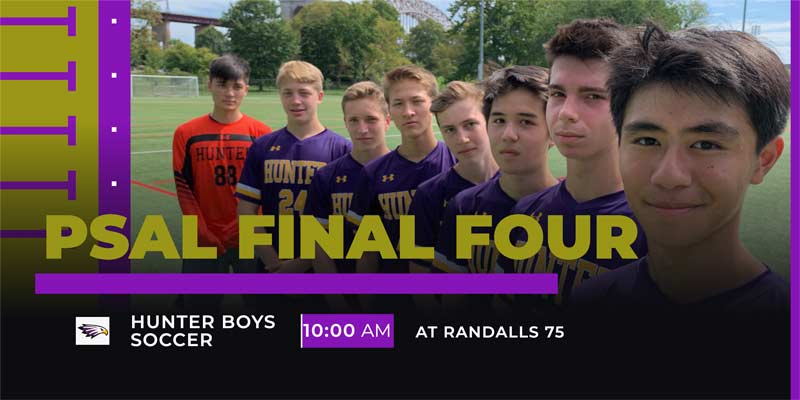
When I collected these reflections, the Hunter Boys were one penalty kick away from the city championship finals. We played a shortened spring 2021 season with no playoffs due to the pandemic; when we returned fully in fall 2021, we went undefeated and qualified for the city championship finals. We didn’t win the championship, but again we leveled up—adding further evidence to support my process.
High school coaching really distills down to galvanizing your team toward a common goal and educating each athlete in the process for getting them there. Share on XI’ll be the first to admit my understanding of soccer has not increased significantly. High school coaching really distills down to galvanizing your team toward a common goal and educating each athlete in the process for getting them there. Hunter Boys Soccer needed confidence, a more cohesive offensive strategy, and more explicit measures of improvement than just wins and losses. I reconfigured our process to address those deficits and accepted the multi-year timeline.
I don’t like to think of myself as an innovator—I am a young coach who heeds the advice of the best practitioners in sport. I’m still nervous on game day; I still agonize over the day-to-day planning, but that’s where game changers thrive. I know I’m doing something right when I feel like I can never get it right. A shift in team culture comes directly from the coach.
Since you’re here…
…we have a small favor to ask. More people are reading SimpliFaster than ever, and each week we bring you compelling content from coaches, sport scientists, and physiotherapists who are devoted to building better athletes. Please take a moment to share the articles on social media, engage the authors with questions and comments below, and link to articles when appropriate if you have a blog or participate on forums of related topics. — SF

